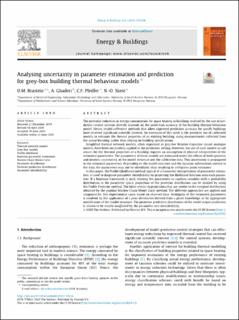| dc.contributor.author | Brastein, O.M. | |
| dc.contributor.author | Ghaderi, Ali | |
| dc.contributor.author | Pfeiffer, Carlos | |
| dc.contributor.author | Skeie, Nils-Olav | |
| dc.date.accessioned | 2021-05-10T12:48:10Z | |
| dc.date.available | 2021-05-10T12:48:10Z | |
| dc.date.created | 2020-07-04T11:32:09Z | |
| dc.date.issued | 2020 | |
| dc.identifier.citation | Brastein, O. M., Ghaderi, A., Pfeiffer, C. F., & Skeie, N. O. (2020). Analysing uncertainty in parameter estimation and prediction for grey-box building thermal behaviour models. Energy and Buildings, 224. | en_US |
| dc.identifier.issn | 0378-7788 | |
| dc.identifier.uri | https://hdl.handle.net/11250/2754706 | |
| dc.description.abstract | The potential reduction in energy consumption for space heating in buildings realised by the use of predictive control systems directly depends on the prediction accuracy of the building thermal behaviour model. Hence, model calibration methods that allow improved prediction accuracy for specific buildings have received significant scientific interest. An extension of this work is the potential use of calibrated models to estimate the thermal properties of an existing building, using measurements collected from the actual building, rather than relying on building specifications. Simplified thermal network models, often expressed as grey-box Resistor-Capacitor circuit analogue models, have been successfully applied in the prediction setting. However, the use of such models as soft sensors for the thermal properties of a building requires an assumption of physical interpretation of the estimated parameters. The parameters of these models are estimated under the effects of both epistemic and aleatoric uncertainty, in the model structure and the calibration data. This uncertainty is propagated to the estimated parameters. Depending on the model structure and the dynamic information content in the data, the parameters may not be identifiable, thus resulting in ambiguous point estimates. In this paper, the Profile Likelihood method, typical of a frequentist interpretation of parameter estimation, is used to diagnose parameter identifiability by projecting the likelihood function onto each parameter. If a Bayesian framework is used, treating the parameters as random variables with a probability distribution in the parameter space, projections of the posterior distribution can be studied by using the Profile Posterior method. The latter results in projections that are similar to the marginal distributions obtained by the popular Markov Chain Monte Carlo method. The different approaches are applied and compared for five experimental cases based on observed data. Ambiguity of the estimated parameters is resolved by the application of a prior distribution derived from a priori knowledge, or by appropriate modification of the model structure. The posterior predictive distribution of the model output predictions is shown to be mostly unaffected by the parameter non-identifiability. | en_US |
| dc.language.iso | eng | en_US |
| dc.rights | Navngivelse 4.0 Internasjonal | * |
| dc.rights.uri | http://creativecommons.org/licenses/by/4.0/deed.no | * |
| dc.title | Analysing uncertainty in parameter estimation and prediction for grey-box building thermal behaviour models | en_US |
| dc.type | Peer reviewed | en_US |
| dc.type | Journal article | en_US |
| dc.description.version | publishedVersion | en_US |
| dc.rights.holder | © The Author(s) 2020. | en_US |
| dc.source.volume | 224 | en_US |
| dc.source.journal | Energy and Buildings | en_US |
| dc.identifier.doi | https://doi.org/10.1016/j.enbuild.2020.110236 | |
| dc.identifier.cristin | 1818543 | |
| dc.source.articlenumber | 110236 | en_US |
| cristin.ispublished | true | |
| cristin.fulltext | original | |
| cristin.qualitycode | 2 | |

